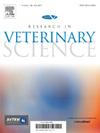Deep-learning classification of teat-end conditions in Holstein cattle
IF 2.2
3区 农林科学
Q1 VETERINARY SCIENCES
引用次数: 0
Abstract
As a means of preventing mastitis, deep learning for classifying teat-end conditions in dairy cows has not yet been optimized. By using 1426 digital images of dairy cow udders, the extent of teat-end hyperkeratosis was assessed using a four-point scale. Several deep-learning networks based on the transfer learning approach have been used to evaluate the conditions of the teat ends displayed in the digital images. The images of the teat ends were partitioned into training (70 %) and validation datasets (15 %); afterwards, the network was evaluated based on the remaining test dataset (15 %). The results demonstrated that eight different ImageNet models consistently achieved high accuracy (80.3–86.6 %). The areas under the receiver operating characteristic curves for the normal, smooth, rough, and very rough classification scores in the test data set ranged from 0.825 to 0.999. Thus, improved accuracy in image-based classification of teat tissue conditions in dairy cattle using deep learning requires more training images. This method could help farmers reduce the risks of intramammary infections, decrease the use of antimicrobials, and better manage costs associated with mastitis detection and treatment.
荷斯坦牛乳头末端状况的深度学习分类
作为预防乳腺炎的一种手段,用于对奶牛乳头末端状况进行分类的深度学习尚未得到优化。通过使用 1426 张奶牛乳房的数字图像,使用四点量表评估了乳头末端过度角化的程度。基于迁移学习方法的多个深度学习网络被用于评估数字图像中显示的乳头末端状况。乳头末端的图像被分为训练数据集(70%)和验证数据集(15%),然后根据剩余的测试数据集(15%)对网络进行评估。结果表明,8 个不同的 ImageNet 模型都达到了很高的准确率(80.3%-86.6%)。在测试数据集中,正常、平滑、粗糙和非常粗糙分类分数的接收器操作特征曲线下的面积在 0.825 到 0.999 之间。因此,利用深度学习提高基于图像的奶牛乳头组织状况分类的准确性需要更多的训练图像。这种方法可以帮助牧场主降低乳房内感染的风险,减少抗菌素的使用,并更好地管理与乳腺炎检测和治疗相关的成本。
本文章由计算机程序翻译,如有差异,请以英文原文为准。
求助全文
约1分钟内获得全文
求助全文
来源期刊

Research in veterinary science
农林科学-兽医学
CiteScore
4.40
自引率
4.20%
发文量
312
审稿时长
75 days
期刊介绍:
Research in Veterinary Science is an International multi-disciplinary journal publishing original articles, reviews and short communications of a high scientific and ethical standard in all aspects of veterinary and biomedical research.
The primary aim of the journal is to inform veterinary and biomedical scientists of significant advances in veterinary and related research through prompt publication and dissemination. Secondly, the journal aims to provide a general multi-disciplinary forum for discussion and debate of news and issues concerning veterinary science. Thirdly, to promote the dissemination of knowledge to a broader range of professions, globally.
High quality papers on all species of animals are considered, particularly those considered to be of high scientific importance and originality, and with interdisciplinary interest. The journal encourages papers providing results that have clear implications for understanding disease pathogenesis and for the development of control measures or treatments, as well as those dealing with a comparative biomedical approach, which represents a substantial improvement to animal and human health.
Studies without a robust scientific hypothesis or that are preliminary, or of weak originality, as well as negative results, are not appropriate for the journal. Furthermore, observational approaches, case studies or field reports lacking an advancement in general knowledge do not fall within the scope of the journal.
 求助内容:
求助内容: 应助结果提醒方式:
应助结果提醒方式:


